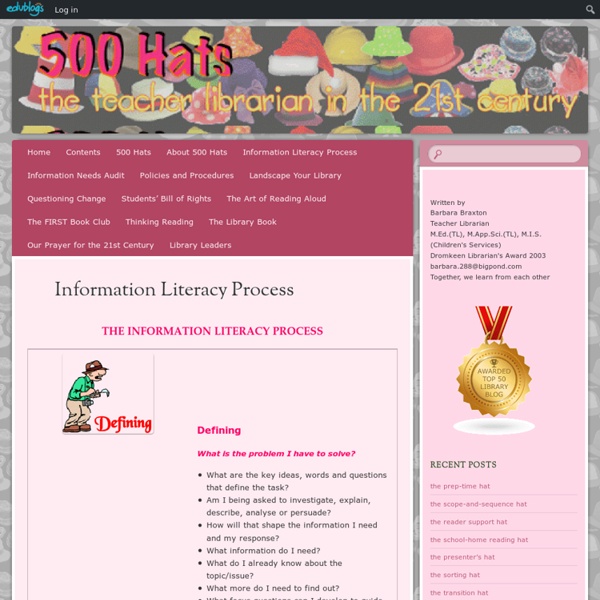



http://500hats.edublogs.org/information-literacy-process/
Related: Information Literacy ClassroomCommon Core in Action: 10 Visual Literacy Strategies Do you wish your students could better understand and critique the images that saturate their waking life? That's the purpose of visual literacy (VL), to explicitly teach a collection of competencies that will help students think through, think about and think with pictures. Standards Support Visual Literacy Instruction Teaching Information Literacy Now Last week, a new study from Stanford University revealed that many students are inept at discerning fact from opinion when reading articles online. The report, combined with the spike in fake and misleading news during the 2016 election, has school librarians, including me, rethinking how we teach evaluation of online sources to our students. How can we educate our students to evaluate the information they find online when so many adults are sharing inaccurate articles on social media? While social media isn’t the only reason for the surge in fake news over the last 10 years, it’s certainly making it harder for information consumers of every age to sort through fact and fiction. As articles about the Stanford study get shared around Facebook, I have two thoughts.
“Calling BS”: Watch Lectures for the College Course Designed to Combat the Bullshit in our Information Age This past January, we highlighted a syllabus for a tentative course called "Calling Bullshit," designed by two professors at the University of Washington, Carl Bergstrom and Jevin West. The course--also sometimes called "Calling Bullshit in the Age of Big Data"--ended up being offered this spring. And now you can see how it unfolded in the classroom. The 10 video lectures from the class are available online. Watch them above, or at this YouTube playlist.
21st Century Skills: Museums, Libraries The IMLS Project Team and Task Force considered the list of skills commonly referred to as "21st Century Skills" and modified it slightly to better align with library and museum priorities.1 The resulting list includes the following additions: Basic Literacy, Scientific & Numerical Literacy, Visual Literacy, Cross-Disciplinary Skills, and Environmental Literacy. Not every skill on this list will be aligned with every institution’s vision and mission. Further, not every community will prioritize the same skills. Library and museum leaders should consider this list as a starting point beyond which it should be customized to fit the unique character, requirements, and priorities of the institution and its audiences.
10 Team-Building Games That Promote Collaborative Critical Thinking 10 Team-Building Games That Promote Critical Thinking by TeachThought Staff One of education’s primary goals is to groom the next generation of little humans to succeed in the ‘real world.’ Yes, there are mounds of curricula they must master in a wide breadth of subjects, but education does not begin and end with a textbook or test. Endungen.de - Weisst du wie's endet? - Das Dateiendungen-Nachschlagewerk im Internet